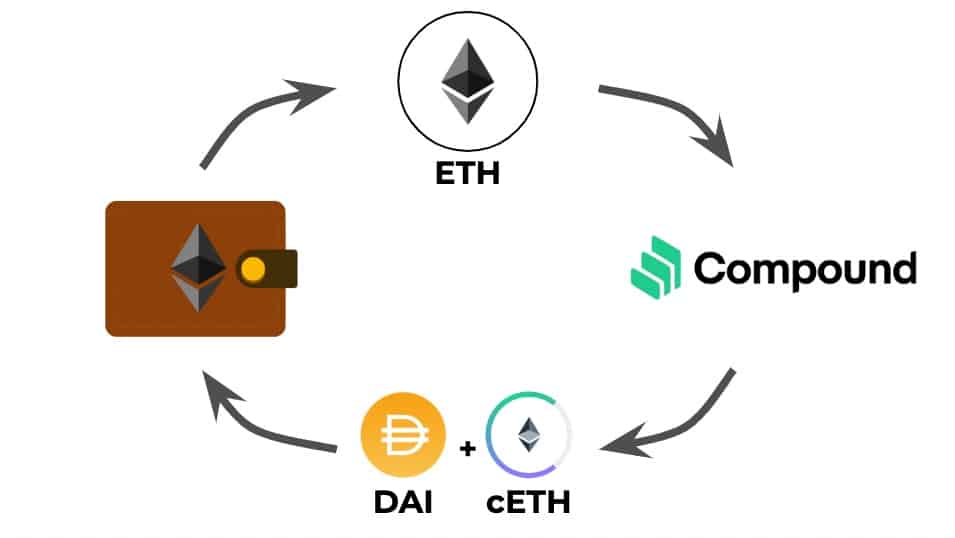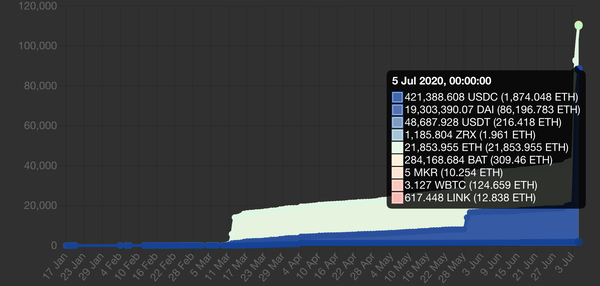2021-3-8 22:34 |
Aave is a decentralized, open-source, non-custodial liquidity protocol that enables users to earn interest on cryptocurrency deposits, as well as borrow assets through smart contracts.
Aave is interesting (pardon the pun) because interest compounds immediately, rather than monthly or yearly. Returns are reflected by an increase in the number of AAVE tokens held by the lending party.
Apart from helping to generate earnings, the protocol also offers flash loans. These are trustless, uncollateralized loans where borrowing and repayment occur in the same transaction.
Assets on Aave as of 3/7/21 (source: aave homepage)
The following article explores Aave’s history, services, tokenomics, security, how the protocol works, and what users should be wary of when using the Aave platform.
How Does Aave Work?The Aave protocol mints ERC-20 compliant tokens in a 1:1 ratio to the assets supplied by lenders. These tokens are known as aTokens and are interest-bearing in nature. These tokens are minted upon deposit and burned when redeemed.
These aTokens, such as aDai, are pegged at a ratio of 1:1 to the value of the underlying asset – that is Dai in the case of aDai.
The lending-borrowing mechanism of the Aave lending pool dictates that lenders will send their tokens to an Ethereum blockchain smart contract in exchange for these aTokens — assets that can be redeemed for the deposited token plus interest.
atokens on Aave
Borrowers withdraw funds from the Aave liquidity pool by depositing the required collateral and, also, receive interest-bearing aTokens to represent the equivalent amount of the underlying asset.
Each liquidity pool, the liquidity market in the protocol where lenders deposit and borrowers withdraw from, has a predetermined loan-to-value ratio that determines how much the borrower can withdraw relative to their collateral. If the borrower’s position goes below the threshold LTV level, they face the risk of liquidation of their assets.
Humble Beginnings as ETHLendAave was founded in May 2017 by Stani Kulechov as a decentralized peer-to-peer lending platform under the name ETHLend to create a transparent and open infrastructure for decentralized finance. ETHLend raised 16.5 million US dollars in its Initial Coin Offering (ICO) on November 25, 2017.
Kulechov, currently serving also as the CEO of Aave, has successfully led the company into the list of top 50 blockchain projects published by PWC. Aave is headquartered in London and backed by credible investors, such as Three Arrows Capital, Framework Ventures, ParaFi Capital, and DTC Capital.
ETHLend widened its bouquet of offerings and rebranded to Aave by September 2018. The Aave protocol was formally launched in January 2020, switching to the liquidity pool model from a Microstaking model.
To add context to this evolution from a Microstaking model to a Liquidity Pool model, Microstaking was where everyone using the ETHLend platform. Whether one is applying for a loan, funding a loan, or creating a loan offer, they had to purchase a ticket to obtain the rights to use the application, and that ticket had to be paid in the platform’s native token LEND. The ticket was previously a small amount pegged to USD, and the total number of LEND needed varied based on the token’s value.
In the liquidity pool model, Lenders deposit funds to liquidity pools. Thus creating what’s known as a liquidity market, and borrowers can withdraw funds from the liquidity pools by providing collateral. In case the borrowers become undercollateralized, they face liquidation.
Aave raised another 4.5 million US dollars from an ICO and 3 million US dollars from Framework Ventures on July 8th and July 15th, 2020.
Aave PronunciationAave is typically pronounced “ah-veh.”
Aave’s Products and ServicesThe Aave protocol is designed to help people lend and borrow cryptocurrency assets. Operating under a liquidity pool model, Aave allows lenders to deposit their digital assets into liquidity pools to a smart contract on the Ethereum blockchain. In exchange, they receive aTokens — assets that can be redeemed for the deposited token plus interest.
Borrowers can take out a loan by putting their cryptocurrency as collateral. The liquidity protocol of Aave, as per the latest available numbers, is more than 4.73 billion US dollars strong.
Flash Loans
Aave’s Flash loans are a type of uncollateralized loan option, which is a unique feature even for the DeFi space. The Flash Loan product is primarily utilized by speculators seeking to take advantage of quick arbitrage opportunities.
Borrowers can instantly borrow cryptocurrency for a matter of seconds; they must return the borrowed amount to the pool within one transaction block. If they fail to return the borrowed amount within the same transaction block, the entire transaction reverses and undo all actions executed until that point.
Flash loans encourage a wide range of investment strategies that typically aren’t possible in such a short window of time. If used properly, a user could profit through arbitrage, collateral swapping, or self-liquidation.
Rate Switching
Aave allows borrowers to switch between fixed and floating rates, which is a fairly unique feature in DeFi. Interest rates in any DeFi lending and borrowing protocol are usually volatile, and this feature offers an alternative by providing an avenue of fixed stability.
For example, if you’re borrowing money on Aave and expect interest rates to rise, you can switch your loan to a fixed rate to lock in your borrowing costs for the future. In contrast, if you expect rates to decrease, you can go back to floating to reduce your borrowing costs.
Aave Bug Bounty CampaignAave offers a bug bounty for cryptocurrency-savvy users. By submitting a bug to the Aave protocol, you can earn a reward of up to $250,000.
Aave TokenomicsThe maximum supply of the AAVE token is 16 million, and the current circulating supply is a little above 12.4 million AAVE tokens.
Initially, AAVE had 1.3 billion tokens in circulation. But in a July 2020 token swap, the protocol swapped the existing tokens for newly minted AAVE coins at a 1:100 ratio, resulting in the current 16 million supply. Three million of these tokens were kept in reserve allocated to the development fund for the core team.
Aave’s price has been fairly volatile, with an all-time high of $559.12 on February 10, 2021. The lowest price was $25.97 on November 5th, 2020.
Aave SecurityAave stores funds on a non-custodial smart contract on the Ethereum blockchain. As a non-custodial project, users maintain full control of their wallets.
Aave governance token holders can stake their tokens in the safety module, which acts as a sort of decentralized insurance fund designed to ensure the protocol against any shortfall events such as contract exploits. In the module, the stakers can risk up to 30% of the funds they lock in the module and earn a fixed yield of 4.66%.
The safety module has garnered $375 million in deposits, which is arguably the largest decentralized insurance fund of its kind.
AAVE Token PriceAave emerged as one of the fastest-growing projects in the Summer 2020 DeFi craze. At the beginning of July 2020, the total value locked in the protocol was just above $115 million US dollars. In less than a year, on February 13, 2021, the protocol crossed the mark of 6 billion US dollars.
Final Thoughts: Why is Aave Important?Aave is a DeFi protocol built on strong fundamentals and has forced other competitors in the DeFi space to bolster their value propositions to stay competitive. Features such as Flash loans and Rate switching offer a distinct utility to many of its users. The project currently allows borrowing and lending in 20 cryptocurrencies.
Aave is important because it shows how ripe the DeFi space is for disruption with new innovative features and how much room there is to grow.
Looking to see how Aave compares to another rapidly-growing DeFi project? Check out our guide on Aave vs. Compound.
The post What is Aave? An Overview of the Budding DeFi Lending Platform appeared first on CoinCentral.
origin »Aave (LEND) на Currencies.ru
|
|










